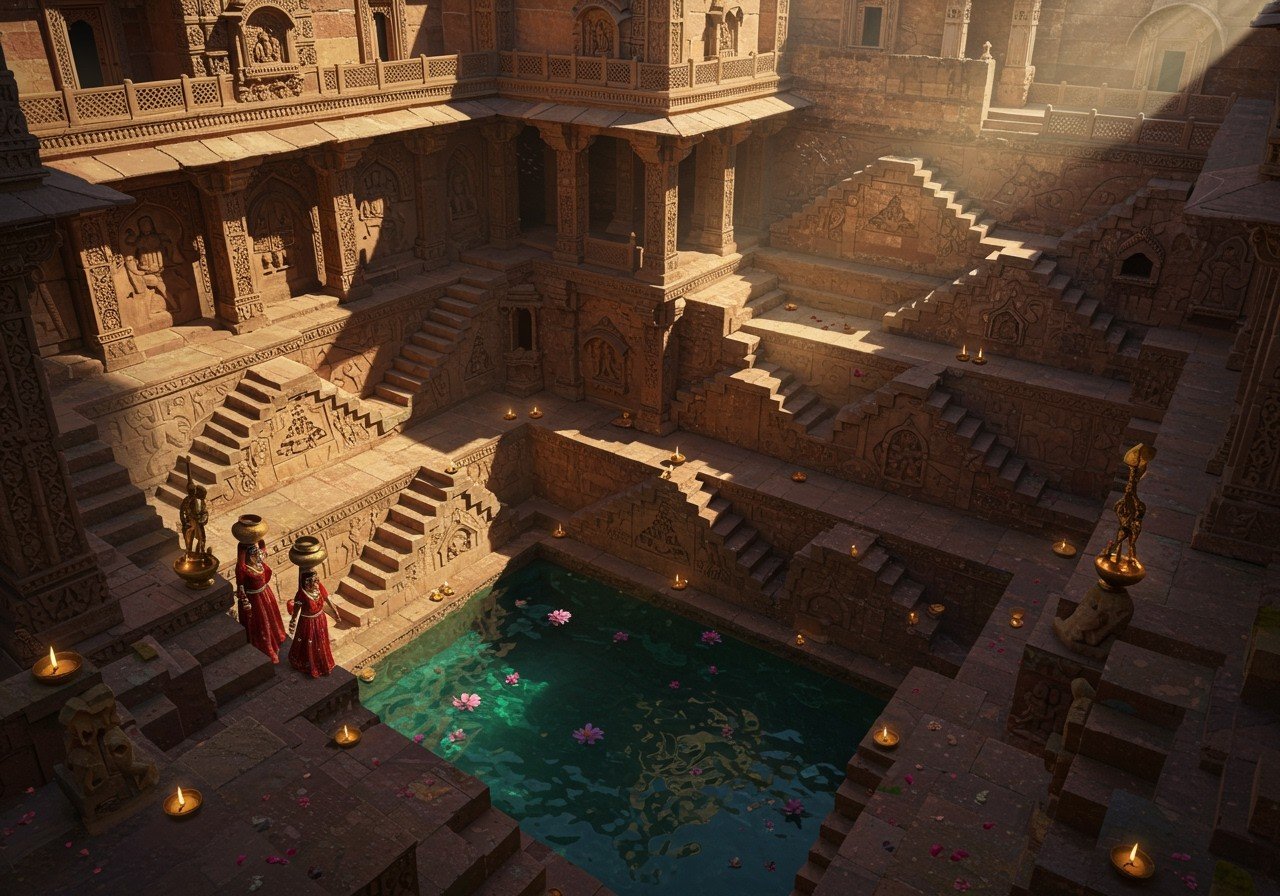
Stepwell architecture forms a significant part of India’s historical and cultural landscape. These ancient water systems, known as stepwells, are engineering and design marvels, showcasing the ingenuity and craftsmanship of their creators. This guide delves into the history, significance, and intricate drawings and designs of stepwells, providing a visual journey into this captivating aspect of ancient water architecture.
History and Significance of Stepwells
Stepwells, also called ‘baoris’ or ‘vavs,’ have been essential to India’s water management for centuries. Originating around the 3rd century CE, these structures were mainly built in arid regions to provide a dependable water source.
Historical Development
- Early Origins: Stepwells began as simple excavations to reach groundwater, providing a vital source of water in arid regions.
- Evolution: Over time, they transformed into multi-story edifices with elaborate carvings and sculptures, showcasing the evolution of architectural design and engineering.
- Notable Examples:
- Rani ki Vav in Gujarat: Renowned for its intricate carvings and UNESCO World Heritage Site status.
- Chand Baori in Rajasthan: Famous for its deep, symmetrical steps and impressive geometric design.
Cultural and Religious Significance
Stepwells served both practical and socio-religious purposes:
- Social Gathering Places: They acted as community hubs where people interacted, fostering social bonds and shared experiences.
- Temples: Many stepwells were designed as temples, integrating religious significance into their architecture and purpose.
Architectural Impact
Stepwells played a key role in ancient urban planning:
- Water Management: They ensured a consistent water supply, crucial for sustaining communities in dry regions.
- Community Impact: Stepwells significantly influenced the daily lives of local communities, providing a vital resource and social space.
Understanding Stepwell Drawings
Stepwell drawings are crucial for preserving and studying these ancient structures. Architectural drawings help document their design and construction, providing valuable insights into the engineering and artistry involved.
Types of Drawings
Different types of drawings used in stepwell architecture include:
- Plans: Overhead views showing the layout and organization of the stepwell, crucial for understanding its spatial arrangement.
- Elevations: Side views displaying the height and design elements, showcasing the vertical aspects and aesthetic details.
- Sections: Cross-sectional views revealing the interior structure and construction techniques, offering insights into the engineering behind the stepwell.
Symbolism and Motifs
Stepwell designs often incorporate symbolic elements:
- Geometric Patterns: Symmetrical designs and intricate patterns reflect the mathematical precision and aesthetic sensibilities of the time.
- Mythological Figures: Carvings depicting gods and legends add religious and cultural significance to the stepwell’s narrative.
Techniques and Materials
Ancient architects employed various materials and techniques:
- Materials: Stone, brick, and mortar were primary materials, chosen for their durability and availability.
- Techniques: Detailed carving and precise measurements demonstrate the skill and craftsmanship of the builders.
Modern Technology
Today, modern technology aids in studying stepwell drawings:
- 3D Modeling: Creates accurate digital representations, enabling detailed analysis and visualization of the stepwell.
- Digital Mapping: Preserves intricate details and facilitates documentation, ensuring the long-term preservation of stepwell heritage.
Creating Stepwell Drawings
Drawing a stepwell is a challenging but rewarding task requiring an understanding of architectural principles and meticulous attention to detail.
Step-by-Step Guide to Drawing a Basic Stepwell
- Start with Simple Shapes: Begin with basic geometric shapes like rectangles and squares to establish the overall structure.
- Add Depth and Perspective: Use perspective lines to create a three-dimensional effect, making the steps appear realistic.
- Incorporate Details: Gradually add features like railings, pillars, and carvings, drawing inspiration from existing stepwells.
- Focus on Proportion: Ensure that the steps and architectural elements are proportionately scaled for a balanced and harmonious design.
Capturing Intricate Details
- Use Fine Lines: Employ fine lines to depict intricate carvings and patterns, enhancing the visual richness of the drawing.
- Highlight Shadows: Use shading techniques to emphasize the depth and dimensions of carvings, creating a sense of realism.
- Detail Orientation: Focus on specific sections at a time to maintain clarity and precision in capturing intricate details.
Tools and Materials
- Pencils: Various grades (H, B) for different line weights and shading effects.
- Rulers and Compasses: Essential for accurate measurements and drawing precise geometric shapes.
- Erasers: Allow for corrections and refinements, ensuring a clean and polished final drawing.
Easy Exercises for Beginners
- Draw Basic Steps: Practice drawing staircases with correct perspective to develop a foundational skill.
- Simple Geometric Patterns: Sketch common geometric patterns found in stepwells to familiarize yourself with their design language.
- Miniature Elements: Focus on drawing small architectural elements like pillars or brackets to improve detail rendering.
Common Mistakes to Avoid
- Ignoring Proportions: Inaccurate proportions can distort the drawing, so maintain accurate scaling of elements.
- Overcrowding Details: Avoid excessive details in one area, which can clutter the drawing and obscure important features.
- Skipping Perspective: Neglecting perspective can make the drawing appear flat, so always use perspective lines to create depth.
Example: Rani ki Vav Drawing
- Layout Plan: Start with a plan view showing the overall layout of Rani ki Vav, outlining its key features.
- Elevation View: Draw an elevation view to depict the height and design of the steps, capturing the grandeur of the structure.
- Section View: Create a cross-section to reveal the interior details and construction techniques of Rani ki Vav.
Designing Modern Stepwells
Modern interpretations of stepwell designs blend tradition with contemporary architecture, offering innovative and sustainable solutions.
Principles of Stepwell Design
- Sustainable Water Management: Implement stepwell techniques for rainwater harvesting and groundwater recharge, promoting water conservation.
- Aesthetic Appeal: Incorporate traditional motifs and patterns in landscaping and architectural details, creating visually appealing spaces.
Examples of Contemporary Buildings
The Rajkumari Ratnavati Girls’ School in Jaisalmer exemplifies how traditional stepwell architecture can inspire modern buildings, demonstrating a harmonious blend of heritage and functionality.
Environmental Benefits
- Conserve Water: Modern stepwell designs can contribute to efficient water management systems, reducing water wastage.
- Enhance Sustainability: Promote eco-friendly construction methods and sustainable practices, minimizing environmental impact.
Tips for Modern Stepwell Designs
- Balance Tradition with Functionality: Combine traditional elements with modern needs to create designs that are both aesthetically pleasing and practical.
- Use Local Materials: Employ locally sourced materials to minimize transportation costs and environmental impact, supporting local economies.
- Innovative Techniques: Apply modern technology for construction and maintenance, ensuring efficiency and longevity.
Analyzing Famous Stepwells
Let’s explore some renowned stepwells, highlighting their unique features and architectural brilliance.
Agrasen ki Baoli, Delhi
- Layout: Agrasen ki Baoli features a long, narrow design with deep steps, creating a dramatic visual effect.
- Carvings: The stepwell displays minimal but elegant stonework, showcasing a subtle yet refined aesthetic.
- Historical Context: Its origins are shrouded in mystery, with some believing it dates back to the Mahabharata era and later rebuilt during the Tughlaq dynasty.
Adalaj Stepwell, Gujarat
- Intricate Carvings: Adalaj Stepwell boasts intricate carvings depicting mythological figures and intricate patterns, showcasing exceptional craftsmanship.
- Architecture: Its five-story depth with octagonal levels creates a unique and visually stunning architectural form.
- Legends: It is associated with a poignant legend of Queen Rudabai, who commissioned the stepwell in memory of her husband.
Preservation Efforts
- Regular Maintenance: Ongoing maintenance is crucial to address wear and tear, preserving the structural integrity of stepwells.
- Restoration Projects: Sensitive restoration projects using traditional techniques ensure authenticity and preserve the historical value of these structures.
How Poojn.in Helps You Connect with Stepwell Heritage
Poojn.in offers a unique way to connect with India’s rich stepwell heritage through our curated selection of cultural and ritual items. We understand the importance of maintaining traditions and offer a convenient platform to access authentic products. Our online store and mobile app provide a seamless shopping experience, delivering across India.
Explore related products available at poojn.in:
- Radha Krishna Bigraha: Beautifully crafted idols for your home altar.
- Maa Laxmi & Lord Ganesha Murti: Ideal for Diwali and other auspicious occasions.
- Pure copper vessels: For traditional water offerings and rituals.
- Traditional oil lamps (diyas): Add a touch of authenticity to your ceremonies.
- Natural cotton wicks: Essential for oil lamps and traditional lighting.
- Pure ghee: Used in various religious ceremonies and rituals.
- Incense sticks and holders: Create a sacred atmosphere for prayer and meditation.
- Prayer items and ritual kits: Convenient kits for various religious practices.
Download our app today and explore our complete range of traditional items. We offer doorstep delivery across India with secure packaging and quality assurance.
Conclusion
Stepwells stand as remarkable testaments to India’s architectural ingenuity and cultural heritage. Learning about their design and significance offers a glimpse into the wisdom of ancient engineers and the rich traditions surrounding water management. Whether you are an artist, architect, or simply fascinated by history, stepwells offer a wealth of inspiration. By incorporating elements of stepwell design into modern architecture, we can create sustainable and aesthetically pleasing spaces that honor the past while embracing the future. Let us continue to explore, appreciate, and preserve these ancient wonders for generations to come.
FAQs on Stepwell Drawings and Designs
What is a stepwell? A stepwell is an ancient water harvesting structure, primarily found in India, consisting of steps descending to a water source. It served as a reliable water source, especially in arid regions, and often doubled as a social gathering space.
How can I draw a stepwell easily? Start with simple geometric shapes to represent the basic structure, then add details like steps, arches, and pillars, paying attention to perspective and proportions. Observing images of existing stepwells can be helpful.
What materials are used in stepwell designs? Traditionally, stepwells were constructed using locally available materials like stone, brick, and mortar. The choice of materials contributed to their durability and integration with the surrounding environment.
Are there different types of stepwell designs? Yes, stepwell designs vary considerably across different regions and periods. Some are simple and functional, while others are highly ornate, featuring intricate carvings, sculptures, and multiple levels. The architectural style often reflects local traditions and artistic influences.
Why were stepwells built? Stepwells served the primary purpose of providing access to water, particularly in areas with limited rainfall. They also played a significant role as social and religious centers, offering a cool respite from the heat and a place for community gatherings.
Where can I find examples of stepwell drawings? Architectural books, online resources, and historical archives often contain drawings and diagrams of stepwells. Researching specific stepwells like Rani ki Vav or Chand Baori can lead to detailed drawings and architectural plans. Additionally, museums and cultural institutions may hold collections of such drawings.
What are the main features of a stepwell design? The main features include a series of steps descending to a water reservoir, often accompanied by landings, platforms, and pavilions. Decorative elements such as arches, pillars, carvings, and sculptures are common, enhancing the aesthetic appeal and cultural significance of the stepwell.
Can I incorporate stepwell elements into modern designs? Yes, stepwell elements can be incorporated into contemporary architecture and landscape design. The principles of water harvesting, passive cooling, and the use of natural materials can be adapted to create sustainable and aesthetically pleasing buildings and public spaces.


